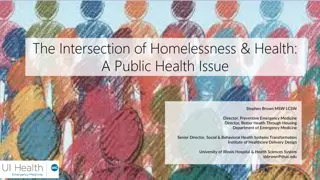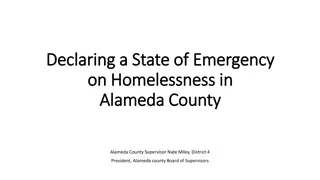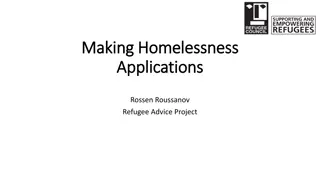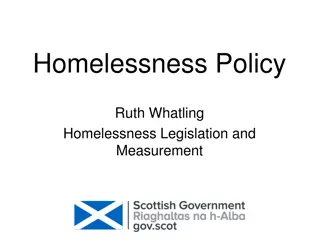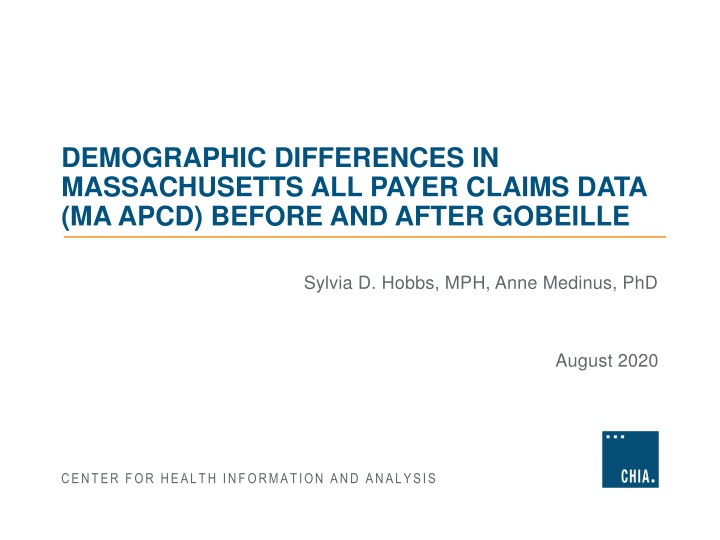
No Place Like Home Program: Addressing Homelessness in California
California's No Place Like Home Program aims to combat the state's high homelessness rates through funding for permanent supportive housing and mental health services. This program, signed into law in 2016, prioritizes vulnerable populations and promotes flexible, voluntary services to improve quality of life for those experiencing homelessness and mental illness. Stakeholder outreach and community involvement are key aspects of implementing this initiative.
Download Presentation

Please find below an Image/Link to download the presentation.
The content on the website is provided AS IS for your information and personal use only. It may not be sold, licensed, or shared on other websites without obtaining consent from the author. If you encounter any issues during the download, it is possible that the publisher has removed the file from their server.
You are allowed to download the files provided on this website for personal or commercial use, subject to the condition that they are used lawfully. All files are the property of their respective owners.
The content on the website is provided AS IS for your information and personal use only. It may not be sold, licensed, or shared on other websites without obtaining consent from the author.
E N D
Presentation Transcript
DEMOGRAPHIC DIFFERENCES IN MASSACHUSETTS ALL PAYER CLAIMS DATA (MA APCD) BEFORE AND AFTER GOBEILLE Sylvia D. Hobbs, MPH, Anne Medinus, PhD August 2020 CENTER FOR HEALTH INFORMATION AND ANALYSIS
Population-Based Data and the MA APCD Applicants for the MA APCD are generally aware of the well published preemptive effect the federal Employment Retirement Income and Security Act of 1974 (ERISA) which regulates employee benefit plans had in the Gobeille v. Liberty Mutual case wherein 2016 the U.S. Supreme Court s deemed ERISA superseded Vermont s APCD reporting requirement. As a consequence in Massachusetts, at the end of 2017, approximately 1.75 million self-insured beneficiaries (that is, 75% of the self-insured) were no longer in the MA APCD. Prior to Gobeille, a frequently stated scientific rationale by researchers applying for the MA APCD was that the MA 2006 Health Care Reform Law resulted in nearly 98% of MA residents having health insurance coverage, consequently the MA APCD represented a unique foundation for empirical research demographically representative of the entire population within the MA geographic boundaries. Indeed, as you can see in Figure 1, there was a very close alignment between the MA Census 2014 population estimate and pre- Gobeille year 2014 MA APCD (both public and private) insurance beneficiaries by age group who were Massachusetts residents with medical coverage. Figure 1. Close 2014 Pre-Gobeille Alignment between MA Census Estimate and MA APCD Population by Age Group 2,100,000 1,800,000 1,500,000 1,200,000 900,000 600,000 300,000 0 Under 5 years 5 to 14 years 15 to 34 years 35 to 54 years 55 to 64 years 65 years and over CENSUS 2014 MA APCD 2014 2
Questions Raised by Data Applicants in the Aftermath of Gobeille SELF-FUNDED PLAN INSURED PLAN Even though applicants are aware of Gobeille vs. Liberty Mutual, a common question asked is what is self-insurance? In answering this question, some applicants become aware that their institution has a self-funded plan and that they could potentially explain to the carrier the utility to the applicant institution (the carrier s client) of having their data submitted. Employer assumes the risk Insurance Company assumes the risk Risk The Employment Retirement Income Security Act of 1974 (ERISA) pre-empts state regulations. The Plan must comply with State Regulations. Governance The employer does not pay a premium, instead, it pays unbundled fixed costs (administrative fees and stop loss premiums) and variable costs (employee health care claims) The employer pays a monthly premium to an insurance carrier. Funding What is Self-Insurance? As defined by the Bureau of Labor Statistics, the concept of self-insurance is a self-funding coverage mechanism of employer sponsored health insurance plans where employers directly assume the major cost of health insurance for their employees. Some self-insured employer plans bear the entire risk. Other self-insured employers insure against large claims by purchasing stop-loss coverage. Some self-insured employers contract with insurance carriers or third party administrators for claims processing and other administrative services; other self-insured plans are self-administered. Minimum Premium Plans (MPP) are included in the self-insured health plan category. All types of plans (Conventional Indemnity, PPO, EPO, HMO, POS, and PHOs) can be financed on a self-insured basis. Employers may offer both self-insured and fully insured plans to their employees. Employers have more control and freedom in their plan designs. Employers are more limited by insurers plan design options. Plan Design 3 .
Questions Raised by Data Applicants in the Aftermath of Gobeille How to Identify the Self-Insured in the MA APCD Given the differences in medical, dental, and pharmacy claims volume due to Gobeille and the differences in beneficiaries in the member eligibility file, data applicants ask how to stratify data by the self-insured. The following fields can be used: APCD ID CODE Enrollment Type Included in ME134, MC241, PC120, DC067 Value Description 1 FIG - Fully-Insured Commercial Group Enrollee 2 SIG - Self-Insured Group Enrollee 3 GIC - Group Insurance Commission Enrollee 4 MCO - MassHealth Managed Care Organization Enrollee 5 Supplemental Policy Enrollee 6 ICO Integrated Care Organization or SCO Senior Care Option 7 ACO Accountable Care Organization Enrollee 0 Unknown / Not Applicable COVERAGE TYPE Type of Policy Covering Member ME029 Value Description ASW Self-funded plans that are administered by a third-party administrator, where the employer has purchased stop-loss, or group excess, insurance coverage ASO Self-funded plans that are administered by a third-party administrator, where the employer has not purchased stop-loss, or group excess, insurance coverage STN Short-term, non-renewable health insurance UND Plans underwritten by the insurer OTH Any other plan. Insurers using this code shall obtain prior approval. 4
Questions Raised by Data Applicants in the Aftermath of Gobeille The MA APCD Release Documentation on the CHIA website clearly explains that due to the Supreme Court decision, Gobeille v. Liberty Mutual, the self-insured plans are severely reduced starting 2016 , consequently some applicants do in advance ask, How severe? Yet other applicants, once they receive the data, nevertheless still ask, Why are data missing? Is something wrong with the extract? For applicants who have been approved to receive both private and public payer data, the impact on medical claims volume is less severe, with a 15% decrease in medical claims volume (see Fig. 1 below). However, for applicants using only private payer data, the impact is quite severe, with an overall 27% decrease in medical claims volume (See Fig. 2 below). Fig 1. MA APCD Medical Claims Total Volume (Private and Public) by Incurred Year 375,000,000 354,433,093 351,418,629 335,793,678 Post-Gobeille 15% Decrease 325,000,000 302,611,215 296,336,963 Pre-Gobeille 275,000,000 2013 2014 2015 2016 2017 Fig 2. MA APCD Medical Claims Total Volume (Private) by Incurred Year 230,743,669 240,000,000 225,530,993 223,355,925 Post-Gobeille 27% Decrease 190,000,000 163,003,246 162,618,682 Pre-Gobeille 140,000,000 2013 2014 2015 2016 2017 5
Questions Raised by Data Applicants in the Aftermath of Gobeille During the MA APCD application review process, some proposed study plans limit their focus to specific demographic groups. Data applicants consequently ask: Gender How does the 75% drop from 2.3 million self-insured beneficiaries in the MA APCD before 2016 to 563,000 in 2018 and 27% drop in medical claims volume impact my proposed study? Population Based Geography Does the impact of Gobeille on the population distribution differ by specific age, gender, and geographic levels? Age How should I describe my study s denominator? Does the impact of Gobeille differ by care setting? Should I use the administrative case mix data instead of the MA APCD? Should I use both the administrative case mix data and the MA APCD? 6
MA APCD (Public and Private) Beneficiaries with Medical Coverage and Census Pre- and Post-Gobeille Age Group Comparison Pre-Gobeille Year 2014 In comparing the Census population estimates for Massachusetts by age-group to the MA APCD pre- Gobeille to post-Gobeille using combined public and private payers, age group differences are evident but less pronounced. 2,100,000 1,800,000 1,500,000 1,200,000 900,000 600,000 300,000 0 Under 5 years 5 to 14 years 15 to 34 years 35 to 54 years 55 to 64 years 65 years and over CENSUS 2014 MA APCD 2014 Pre-Gobeille Year 2015 CENSUS 2014 MA APCD Private 2014 MA APCD Public 2014 2,100,000 1,800,000 Under 5 years 1,500,000 1,200,000 900,000 5 to 14 years 600,000 300,000 0 15 to 34 years Under 5 years 5 to 14 years 15 to 34 years 35 to 54 years 55 to 64 years 65 years and over 35 to 54 years CENSUS 2015 MA APCD 2015 55 to 64 years Post-Gobeille Year 2016 65 years and over 2,100,000 1,800,000 1,500,000 2,500,000 1,500,000 500,000 500,000 1,500,000 2,500,000 1,200,000 900,000 600,000 300,000 0 CENSUS 2017 MA APCD Private 2017 MA APCD Public 2017 Under 5 years 5 to 14 years 15 to 34 years 35 to 54 years 55 to 64 years 65 years and over Under 5 years CENSUS 2016 MA APCD 2016 5 to 14 years 15 to 34 years Post-Gobeille Year 2017 2,100,000 1,800,000 35 to 54 years 1,500,000 1,200,000 900,000 55 to 64 years 600,000 300,000 0 65 years and over Under 5 years 5 to 14 years 15 to 34 years 35 to 54 years 55 to 64 years 65 years and over 2,500,000 1,500,000 500,000 500,000 1,500,000 2,500,000 CENSUS 2017 MA APCD 2017 7
MA APCD Private Payer Pre- and Post-Gobeille Age Group Comparison MA APCD Private Payer Pre-Gobeille 2014 compared to Post-Gobeille 2016 -8% -22% -30% -23% -40% -40% 65 years and over 55 to 64 years When the public payer beneficiaries are removed and the comparison is limited to pre- and post Gobeille private payer beneficiaries, the age group differences are quite pronounced: 35 to 54 years 15 to 34 years 5 to 14 years Under 5 years 1,500,000 500,000 500,000 1,500,000 Pre-Gobeille 2014 Post-Gobeille 2016 MA APCD Private Payer Pre-Gobeille 2015 compared to Post-Gobeille 2017 Highest for the pediatric population ages 14 years old and younger (40% and greater) -6% -23% -28% -26% -44% -41% 65 years and over 55 to 64 years 35 to 54 years 15 to 34 years Lowest for the senior population ages 65 years and older (8% and lower) 5 to 14 years Under 5 years 1,500,000 500,000 500,000 1,500,000 Pre-Gobeille 2015 Post-Gobeille 2017 8
Example of High Impact on Pediatric Population FY2014 to 2016 MA APCD Asthma Outpatient Pediatric Primary Care Report (Ages 2 to 17 years old) (Note: Fiscal Year used to align with ICD-10-CM implementation) OUTPATIENT PRIMARY CARE FY2014 ICD-Code Private Insurance # of PCP Visits Public Insurance # of PCP Visits # of Distinct Patients # of Distinct Patients 265,393 150,598 345,898 151,933 All ICD-9-CM 9,674 7,067 19,303 12,165 493.0X, 493.1X, 493.2X, 493.8X, 493.9X Principal DX 6,990 5,723 13,993 10,494 493.0X, 493.1X, 493.2X, 493.8X, 493.9X Associated DX OUTPATIENT PRIMARY CARE FY2015 ICD-Code Private Insurance # of PCP Visits Public Insurance # of PCP Visits # of Distinct Patients # of Distinct Patients 338,518 185,176 407,794 180,660 All ICD-9-CM 10,090 7,467 19,994 13,055 493.0X, 493.1X, 493.2X, 493.8X, 493.9X Principal DX 7,773 6,310 17,724 13,118 493.0X, 493.1X, 493.2X, 493.8X, 493.9X Associated DX OUTPATIENT PRIMARY CARE FY2016 ICD-Code Private Insurance # of PCP Visits Public Insurance # of PCP Visits # of Distinct Patients # of Distinct Patients 143,316 79,697 434,394 186,554 All ICD-10-CM J45, J45.2X, J45.3X, J45.4X, J45.5X, J45.90X, J45.99X Principal DX J45, J45.2X, J45.3X, J45.4X, J45.5X, J45.90X, J45.99X Associated DX 4,236 3,081 20,289 13,098 3,812 3,140 19,112 13,984 9
GENDER In evaluating the total volume of distinct beneficiaries in the Member Eligibility file for all self-insured enrollees by gender regardless of state of residency (see Fig. 1 below), the percent drop for females from calendar year 2015 to calendar year 2016 was 68.1% vs 68.4% for males. State residency did not meaningfully impact the difference between males and females. For MA residents (see Fig. 2 below), the decrease was 56.9% for females vs. 57.7% for males. For non-MA residents (see Fig. 3 below), the decrease was 91.6% for females vs. 91.3% for males. Fig 1. Distinct Beneficiaries Count for All Self-Insured Enrollees by Gender* 2,000,000 Distinct MEIDS Female Male Unknown 1,500,000 1,000,000 500,000 - 2013 2014 2015 2016 2017 Fig 2. Count for MA Resident Self-Insured Enrollees by Gender* Fig 3. Non-MA Resident Self-Insured Enrollees by Gender* 2,000,000 700,000 Distinct MEIDS Distinct MEIDS Female Male Unknown Female Male Unknown 1,500,000 525,000 1,000,000 350,000 500,000 175,000 - - 2013 2014 2015 2016 2017 2013 2014 2015 2016 2017 *Note: The gender category Other was not included due to self-insured enrollee volume < 11
Massachusetts Residents compared to Non-Residents Self-Insured? Although the volume of MA residents in MA APCD remains higher than non-MA residents (see Fig. 1 below) , a distinct count of beneficiaries in the Member Eligibility file stratified by MA residency and APCD ID Code enrollment categories reveals a larger proportional drop in in self- insured non-MA residents than self-insured MA residents (see Table 1 below). Table 1. Distribution of Distinct Members by APCD ID Code Enrollee Category for MA Residents APCD ID CODE 2013 22.796% 1.479% 24.279% 7.500% 2014 24.394% 1.111% 23.504% 6.948% 2015 25.188% 1.163% 23.256% 6.205% 2016 29.939% 0.885% 27.338% 7.737% 2017 30.387% 1.424% 27.540% 8.029% 2018 27.398% 2.125% 25.757% 7.921% Unknown / Not Applicable - MA Unknown / Not Applicable - not MA Fully-Insured Commercial Group - MA Fully-Insured Commercial Group - not MA Self-Insured Group Enrollee - MA Self-Insured Group Enrollee - not MA Group Insurance Commission - MA Group Insurance Commission - not MA MassHealth Managed Care Organization - MA MassHealth Managed Care Organization - not MA Supplemental Policy Enrollee - MA Supplemental Policy Enrollee - not MA Integrated Care Organization or Senior Care Option - MA Integrated Care Organization or Senior Care Option - not MA Accountable Care Organization - MA Accountable Care Organization - not MA TOTAL DISTINCT MEMBER LINK EIDS 18.154% 7.189% 2.819% 0.257% 12.746% 0.156% 17.839% 8.084% 2.932% 0.270% 12.101% 0.151% 16.634% 7.932% 2.601% 0.173% 12.633% 0.157% 8.917% 0.843% 3.667% 0.355% 16.405% 0.217% 8.240% 1.735% 2.951% 0.214% 15.020% 0.178% 7.965% 1.475% 2.582% 0.196% 14.629% 0.245% 2.389% 0.233% 0.004% 0.000% 0.000% 0.000% 2.342% 0.215% 0.110% 0.000% 0.000% 0.000% 2.857% 0.759% 0.439% 0.002% 0.000% 0.000% 2.601% 0.172% 0.789% 0.004% 0.131% 0.000% 3.155% 0.326% 0.797% 0.004% 0.000% 0.000% 2.913% 0.303% 0.747% 0.004% 5.717% 0.025% 13,911,141 14,516,889 14,452,024 11,831,014 12,085,306 13,769,718 Figure 1. Change in Annual Volume of Self-Insured Group Enrollees MA Residency vs. Non-Residents 1,400,000 3,000,000 MA Residents Non-MA Residents 2,525,475 1,200,000 1,000,019 2,500,000 1,000,000 2,000,000 800,000 1,500,000 1,096,704 600,000 1,000,000 400,000 203,166 500,000 200,000 - - 2013 2014 2015 2016 2017 2013 2014 2015 2016 2017
RESULTS For each pre-Gobeille year, the percent total population difference between the MA APCD population and Census estimate for Massachusetts remained less than 2%. Post-Gobeille, the percent total population difference between the MA APCD vs Census estimate widened to 24%. The percent post-Gobeille decrease by self-insured enrollment type was highest for non-Massachusetts residents. The magnitude of difference in decrease between males and females (residents or non-residents) was not meaningful, both were equally high (> 50%). Applicants should be warned of pronounced age-group differences in decreases and how population-level data deficiencies impact having a fully representative count routinely used for epidemiologic inference 12
CONCLUSION Future efforts to maximize the post-Gobeille utility of the all payer claims data should continue to assess variation in population decreases at the geographic and age- group level that may impact the magnitude of expected population for specific types of demographically targeted studies The care setting for data used should be assessed so that the applicant understands the difference between the MA APCD and administrative case mix data Applicants and their institutions are in a unique position to ask their carriers to participate in submitting their institutions data to the MA APCD. 13
Contact For questions, please contact: Sylvia D. Hobbs, MPH, Manager of Data Strategy 617-872-8111 sylvia.hobbs@state.ma.us 14


